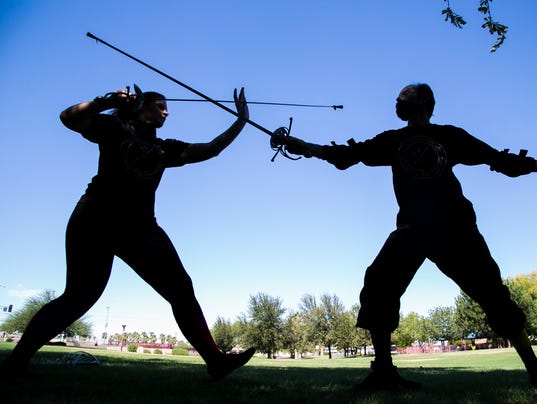Phoenix sword fighters resurrect historical martial art
The Phoenix Society of Historical Swordsmanship is resurrecting the lost art of European sword fighting.
Ryan Van Velzer, The Republic | azcentral.com 8:31 a.m. MST October 6, 2014

Jess Hubbard (left) learns moves from Richard Marsden, co-founder and lead instructor of the Phoenix Society of Historical Swordsmanship, during a practice session on Saturday at Margaret T. Hance Park in downtown Phoenix.(Photo: Patrick Breen/The Republic)
The clash of cold steel echoes off the wood floors inside the Irish Cultural Center's great hall in downtown Phoenix.
A semicircle of masked men and women brandishing steel rapiers cheer on their compatriots and await their turn in the ring.
The battles are quick and fierce.
Foes circle each other, raising and lowering their swords, waiting for a moment of weakness. The goal is simple: Vanquish your opponent.
A flair of swashbuckling ensues. A quick thrust breaks through the opponent's guard. The loser is slain through the heart. Or he or she would be, if these were medieval times.
Instead, it's Saturday morning with the Phoenix Society of Historical Swordsmanship, where members practice one-on-one sword fighting with modern-day safety equipment including fencing masks, knee pads, gloves and rubber stoppers fitted onto the ends of blunted steel rapiers and hard plastic long swords.
That doesn't mean the blows don't leave the occasional welt, but for the sword fighters, it's a small price to pay in order to learn and, in turn, resurrect the lost martial art of Historical European sword fighting.
A lost tradition
Unlike the living traditions of Eastern martial arts such as kung fu and kendo, Europeans gave up Historical European Martial Arts, or HEMA, such as sword fighting in favor of gunpowder, said Christopher Nelson, a member of the leadership council at the Phoenix Society of Historical Swordsmanship.
"Nobody learned Italian rapier from their granddad," Nelson said. "Gunpowder stopped that from happening."
PNI sword JUMP

Lead Instructor Richard Marsden (center) has Phoenix Society of Historical Swordsmanship members Adam Barrett (right) and Anthony Marcarelli work on their long swords during a Saturday practice. During the week, Marsden is a high-school history teacher.(Photo: Patrick Breen/The Republic)
As a result, students at the Phoenix Society of Historical Swordsmanship study the few remaining texts to reconstruct historical fighting systems. Primarily, the club recreates Italian and German traditions of sword fighting using rapier and long sword, though they also learn to fight with sword and buckler, dussack, small sword, spear, poleaxe (a long-handled Warhammer) and more.
The society's co-founder, Richard Marsden, has studied European Martial Arts for 17 years, won multiple national tournaments and served as president of the HEMA Alliance, a national organization that holds tournaments around the country.
Marsden is also a history teacher at Peoria High School. At the Phoenix Society of Historical Swordsmanship, Marsden uses a ranking system that allows students to ascend not just on their fighting ability, but on their academics.
Students are rated on their ability to read, interpret and understand historical texts in addition to their leadership, teaching ability and swordsmanship.
Although Marsden began the Phoenix club in 2009, it wasn't until 2014 that sword fighting as a martial art caught the public's attention. In the past year, Marsden has watched the club grow from a dozen regulars one day a week to 60 regulars practicing multiple nights.
"It's an undiscovered art," Marsden said. "There's been attempts to re-create it before, but not like now."
Popularity on rise
Part of that can be attributed to popular culture's recent fascination with medieval times, thanks in part to shows such as "Game of Thrones" and video games such as Dark Souls. For the Phoenix Society, demonstrations at this year's Phoenix Comicon bolstered the club's popularity and prompted people to join its ranks.
Phoenix Swordmanship

Two sword fighters duel with rapiers for the Phoenix Society of Historical Swordsmanship.(Photo: Ryan Van Velzer/The Republic)
Kari Baker, 25, was one of a handful of women who joined the club after watching the rapier demonstration at Phoenix Comicon. Baker said she likes that the club uses a historically based fighting system, as opposed to medieval re-enactment groups such as the Society for Creative Anarchism, whose fighting system has little foundation in historical texts.
"I really like that they had a firm sense of reality," she said.
Cliff Curry, 32, became interested in the Phoenix Society of Historical Swordsmanship through competitive fencing, which he's done for 16 years. Though the sports share similarities, each has its own system of rules, he said. In the Phoenix Society of Historical Swordsmanship, fighters are taught to protect themselves while delivering a strike, unlike fencing, where the goals is to strike your opponent first regardless of getting hit.
Like a 'chess match'
"My philosophy with long sword is 'The pointy end goes into the other man,'" Curry said. "I really like the chess match of all the ins and outs of trying to get the pointy end into the other man."
Members must be 18 years old or older, fit enough to hold a 2-to 3-pound weapon and tough enough to get whacked with a sword.
For more information about the society,
go to phoenixswordclub.com.
If you go
Interested in watching — or perhaps joining — the Phoenix Society of Historical Swordsmanship? It meets on Saturdays from 9 a.m. to noon at Margaret T. Hance Park, Culver Street just west of Central Avenue, near the Irish Cultural Center. There's no cost to check it out. More info: phoenixswordclub.com.




 Reply With Quote
Reply With Quote




